Papers by Alexandre Helder
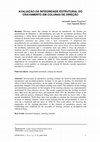
Engevista, 2010
Diversas partes das colunas de direção de automóveis são fixadas por interferência de diâmetros e... more Diversas partes das colunas de direção de automóveis são fixadas por interferência de diâmetros e, adicionalmente, por ação de cravamento mecânico. Para determinar o efeito destes procedimentos na fixação dos rolamentos nas juntas de colunas de direção foram realizados ensaios de remoção dos rolamentos. Foram testadas populações amostrais das juntas com e sem cravamento. A influência dos procedimentos de cravamento e da interferência dimensional na integridade das colunas de direção foi determinada experimentalmente com curvas força versus deslocamento. Os resultados indicaram que o cravamento mais que dobra a força de remoção e aumenta em 24% a energia absorvida na remoção total. Testes estatísticos de aderência mostraram que a força de remoção obedece a uma distribuição log-normal. A partirdestes dados pôde-se determinar a confiabilidade estrutural das juntas de colunas de direção, cujo resultado indica que com o cravamento a taxa esperada de falha é próxima de zero para uma carga...
Filigrane: Écoutes psychothérapiques, 2017
Cet article vise à illustrer les concepts psychanalytiques d’appropriation subjective, de symboli... more Cet article vise à illustrer les concepts psychanalytiques d’appropriation subjective, de symbolisation, de culpabilité primaire et d’entrejeu psychothérapique à travers une vignette clinique. Ces concepts s’appuient sur la pensée de plusieurs auteurs dont principalement Freud, Winnicott et Roussillon. Je ferai d’abord un bref résumé théorique des notions précédemment mentionnées. Ensuite, j’illustrerai chacun de ces concepts à travers une même vignette clinique. Concernant la patiente présentée, elle a été suivie par l’auteur dans un service hospitalier en clinique externe de psychiatrie. Certaines modifications ont été apportées afin de préserver l’anonymat de la patiente.

Revista de Neurología, 2000
INTRODUCTION The Sturge-Weber syndrome is characterized by facial cutaneous angioma associated wi... more INTRODUCTION The Sturge-Weber syndrome is characterized by facial cutaneous angioma associated with leptomeningeal and cerebral angioma, typically ipsilateral to the facial lesion, which is accompanied by convulsions, mental retardation, contralateral hemiparesia, hemiatrophy, homonymous hemianopsia and glaucoma. Most of the patients with radiographic evidence of intracranial angioma develop convulsive crises, but only half have severe mental retardation. The image of calcification on cranial tomography often leads to confusion in diagnosis, especially with neurocysticercosis, particularly in places where this is endemic and the patients present with minimal skin lesions or these are at atypical sites. CLINICAL CASE We present the case of a 13 year-old boy hospitalized with status epilepticus who, since the age of 1 year and 3 months, had had convulsive seizures which were of generalized tonic-clonic type and partially complex with secondary generalization, treated with carbamazepine at a dose of 400 mg per day. Neurocysticercosis was diagnosed on a tomogram showing calcification of the left parieto-occipital gyrus. Following physical examination and complementary tests the diagnosis of Sturge-Weber syndrome was made. CONCLUSION We emphasize the importance of the diagnosis of Sturge-Weber syndrome, its clinical picture and treatment.
Quick HyperVolume Implementations, including parallel versions and the exclusive version. Quick H... more Quick HyperVolume Implementations, including parallel versions and the exclusive version. Quick HyperVolume is an algorithm that computes the HyperVolume occupied by a set of hyper-rectangles, that share the "lower leftmost" vertex. A full description of the non-parallel and non-exclusive algorithm is published in IEEE Transactions on Evolutionary Computation (http://dx.doi.org/10.1109/TEVC.2013.2281525). The parallel and exclusive extension is published in <em>Journal of Heuristics</em> (http://dx.doi.org/10.1007/s10732-016-9309-6).
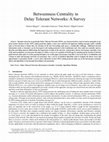
Ad Hoc Networks, 2015
Dynamic networks, in particular Delay Tolerant Networks (DTNs), are characterized by a lack of en... more Dynamic networks, in particular Delay Tolerant Networks (DTNs), are characterized by a lack of end-to-end paths at any given instant. Because of that, DTN routing protocols employ a store-carry-and-forward approach, holding messages until a suitable node to forward them is found. But, the selection of the best forwarding node poses a considerable challenge. Additional network information (static or dynamic) can be leveraged to aid routing protocols in this troublesome task. One could use centrality metrics, therefore providing means to differentiate the importance of nodes in the network. Among these metrics, betweenness centrality is one of the most prominent, as it measures the degree to which a vertex is in a position of brokerage by summing up the fraction of shortest paths between other pairs of vertices passing through it. So, in this paper, betweenness centrality is surveyed, that is, its definitions and variants in static and dynamic networks are presented. Also, a survey of standard algorithms used to compute the metric (exact and approximate) is presented. Finally, a survey and a discussion on how DTN routing protocols make use of the betweenness centrality metric and algorithms to aid message forwarding is also presented.
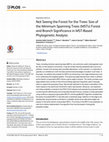
PLOS ONE, 2015
Trees, including minimum spanning trees (MSTs), are commonly used in phylogenetic studies. But, f... more Trees, including minimum spanning trees (MSTs), are commonly used in phylogenetic studies. But, for the research community, it may be unclear that the presented tree is just a hypothesis, chosen from among many possible alternatives. In this scenario, it is important to quantify our confidence in both the trees and the branches/edges included in such trees. In this paper, we address this problem for MSTs by introducing a new edge betweenness metric for undirected and weighted graphs. This spanning edge betweenness metric is defined as the fraction of equivalent MSTs where a given edge is present. The metric provides a per edge statistic that is similar to that of the bootstrap approach frequently used in phylogenetics to support the grouping of taxa. We provide methods for the exact computation of this metric based on the well known Kirchhoff's matrix tree theorem. Moreover, we implement and make available a module for the PHYLOViZ software and evaluate the proposed metric concerning both effectiveness and computational performance. Analysis of trees generated using multilocus sequence typing data (MLST) and the goeBURST algorithm revealed that the space of possible MSTs in real data sets is extremely large. Selection of the edge to be represented using bootstrap could lead to unreliable results since alternative edges are present in the same fraction of equivalent MSTs. The choice of the MST to be presented, results from criteria implemented in the algorithm that must be based in biologically plausible models.
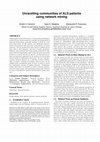
Amyotrophic Lateral Sclerosis is a devastating neurodegenerative disease characterized by a usual... more Amyotrophic Lateral Sclerosis is a devastating neurodegenerative disease characterized by a usually fast progression of muscular denervation, generally leading to death in a few years from onset. In this context, any significant improvement of the patient's life expectancy and quality is of major relevance. Several studies have been made to address problems such as ALS diagnosis, and more recently, prognosis. However, these analysis have been mostly restricted to classical statistical approaches used to find the most associated features to a given outcome of interest. In this work we explore an innovative approach to the analysis of clinical data characterized by multivariate time series. We use a distance measure between patients as a reflection of their relationship, to build a network of patients, that in turn can be studied from a modularity point of view, in order to search for communities (groups of similar patients). Preliminary results show that it is possible to extract relevant information from such groups, each presenting a particular behavior for some of the features (patient characteristics) under analysis.
2014 IEEE International Congress on Big Data, 2014
2010 IEEE International Conference on Bioinformatics and Biomedicine Workshops, BIBMW 2010, 2010
... In this work, we present Needle, a method for de novo motif discovery that works by post-proc... more ... In this work, we present Needle, a method for de novo motif discovery that works by post-processing the output of a ... was integrated with two combinatorial motif finders, MUSA and RISO, and made available through the DISCOV-ERER platform in the YEASTRACT database [ ...

Lecture Notes in Computer Science (including subseries Lecture Notes in Artificial Intelligence and Lecture Notes in Bioinformatics), 2012
In the Microbial typing field, the need to have a common understanding of the concepts described ... more In the Microbial typing field, the need to have a common understanding of the concepts described and the ability to share results within the community is an increasingly important requisite for the continued development of portable and accurate sequence-based typing methods. These methods are used for bacterial strain identification and are fundamental tools in Clinical Microbiology and Bacterial Population Genetics studies. In this article we propose an ontology designed for the microbial typing field, focusing on the widely used Multi Locus Sequence Typing methodology, and a RESTful API for accessing information systems based on the proposed ontology. This constitutes an important first step to accurately describe, analyze, curate, and manage information for microbial typing methodologies based on sequence based typing methodologies, and allows for the future integration with data analysis Web services.
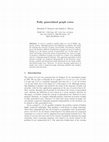
Communications in Computer and Information Science, 2011
A core in a graph is usually taken as a set of highly connected vertices. Although general, this ... more A core in a graph is usually taken as a set of highly connected vertices. Although general, this definition is intuitive and useful for studying the structure of many real networks. Nevertheless, depending on the problem, different formulations of graph core may be required, leading us to the known concept of generalized core. In this paper we study and further extend the notion of generalized core. Given a graph, we propose a definition of graph core based on a subset of its subgraphs and on a subgraph property function. Our approach generalizes several notions of graph core proposed independently in the literature, introducing a general and theoretical sound framework for the study of fully generalized graph cores. Moreover, we discuss emerging applications of graph cores, such as improved graph clustering methods and complex network motif detection.
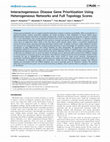
PLoS ONE, 2012
Disease gene prioritization aims to suggest potential implications of genes in disease susceptibi... more Disease gene prioritization aims to suggest potential implications of genes in disease susceptibility. Often accomplished in a guilt-by-association scheme, promising candidates are sorted according to their relatedness to known disease genes. Network-based methods have been successfully exploiting this concept by capturing the interaction of genes or proteins into a score. Nonetheless, most current approaches yield at least some of the following limitations: (1) networks comprise only curated physical interactions leading to poor genome coverage and density, and bias toward a particular source; (2) scores focus on adjacencies (direct links) or the most direct paths (shortest paths) within a constrained neighborhood around the disease genes, ignoring potentially informative indirect paths; (3) global clustering is widely applied to partition the network in an unsupervised manner, attributing little importance to prior knowledge; (4) confidence weights and their contribution to edge differentiation and ranking reliability are often disregarded. We hypothesize that network-based prioritization related to local clustering on graphs and considering full topology of weighted gene association networks integrating heterogeneous sources should overcome the above challenges. We term such a strategy Interactogeneous. We conducted cross-validation tests to assess the impact of network sources, alternative path inclusion and confidence weights on the prioritization of putative genes for 29 diseases. Heat diffusion ranking proved the best prioritization method overall, increasing the gap to neighborhood and shortest paths scores mostly on single source networks. Heterogeneous associations consistently delivered superior performance over single source data across the majority of methods. Results on the contribution of confidence weights were inconclusive. Finally, the best Interactogeneous strategy, heat diffusion ranking and associations from the STRING database, was used to prioritize genes for Parkinson's disease. This method effectively recovered known genes and uncovered interesting candidates which could be linked to pathogenic mechanisms of the disease.
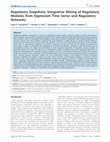
PLoS ONE, 2012
Explaining regulatory mechanisms is crucial to understand complex cellular responses leading to s... more Explaining regulatory mechanisms is crucial to understand complex cellular responses leading to system perturbations. Some strategies reverse engineer regulatory interactions from experimental data, while others identify functional regulatory units (modules) under the assumption that biological systems yield a modular organization. Most modular studies focus on network structure and static properties, ignoring that gene regulation is largely driven by stimulus-response behavior. Expression time series are key to gain insight into dynamics, but have been insufficiently explored by current methods, which often (1) apply generic algorithms unsuited for expression analysis over time, due to inability to maintain the chronology of events or incorporate time dependency; (2) ignore local patterns, abundant in most interesting cases of transcriptional activity; (3) neglect physical binding or lack automatic association of regulators, focusing mainly on expression patterns; or (4) limit the discovery to a predefined number of modules. We propose Regulatory Snapshots, an integrative mining approach to identify regulatory modules over time by combining transcriptional control with response, while overcoming the above challenges. Temporal biclustering is first used to reveal transcriptional modules composed of genes showing coherent expression profiles over time. Personalized ranking is then applied to prioritize prominent regulators targeting the modules at each time point using a network of documented regulatory associations and the expression data. Custom graphics are finally depicted to expose the regulatory activity in a module at consecutive time points (snapshots). Regulatory Snapshots successfully unraveled modules underlying yeast response to heat shock and human epithelial-to-mesenchymal transition, based on regulations documented in the YEASTRACT and JASPAR databases, respectively, and available expression data. Regulatory players involved in functionally enriched processes related to these biological events were identified. Ranking scores further suggested ability to discern the primary role of a gene (target or regulator).
Phytochemical Analysis, 1995
Parkinsonism & Related Disorders, 2007
Nucleic Acids Research, 2007
The Yeast search for transcriptional regulators and consensus tracking (YEASTRACT) information sy... more The Yeast search for transcriptional regulators and consensus tracking (YEASTRACT) information system (www.yeastract.com) was developed to support the analysis of transcription regulatory associations in Saccharomyces cerevisiae. Last
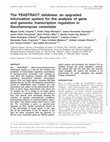
Nucleic Acids Research, 2013
The YEASTRACT (http://www.yeastract.com) information system is a tool for the analysis and predic... more The YEASTRACT (http://www.yeastract.com) information system is a tool for the analysis and prediction of transcription regulatory associations in Saccharomyces cerevisiae. Last updated in June 2013, this database contains over 200 000 regulatory associations between transcription factors (TFs) and target genes, including 326 DNA binding sites for 113 TFs. All regulatory associations stored in YEASTRACT were revisited and new information was added on the experimental conditions in which those associations take place and on whether the TF is acting on its target genes as activator or repressor. Based on this information, new queries were developed allowing the selection of specific environmental conditions, experimental evidence or positive/negative regulatory effect. This release further offers tools to rank the TFs controlling a gene or genome-wide response by their relative importance, based on (i) the percentage of target genes in the data set; (ii) the enrichment of the TF regulon in the data set when compared with the genome; or (iii) the score computed using the TFRank system, which selects and prioritizes the relevant TFs by walking through the yeast regulatory network. We expect that with the new data and services made available, the system will continue to be instrumental for yeast biologists and systems biology researchers.
Journal of Science and Medicine in Sport, 1999





Uploads
Papers by Alexandre Helder